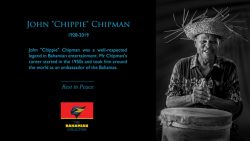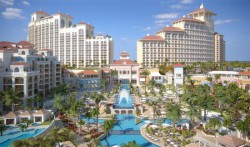The contrast in art being produced in the Bahamas and around the world is sometimes startling.
The photograph was simple, yet incredibly intriguing, a single beam of light exposed the flesh along the back of “The Runner”. A closer read would reveal that the figure, his arms outstretched, leg bent to propel the body forward and mouth open as if drawing in his next breath, was one of 20 cadavers on display at Bodies, The Exhibition, in Tampa, Florida.
Asked whether similar work, one that pushed the envelope, drew from the disdained, the ugly and even frightening, that tested the limits of a civilized society and forced a reaction, was being produced in the Bahamas by Bahamian artists, Antonius Roberts, world class artist and sculpture, said no, with a caveat.
“It’s not being done. That particular exhibition and experimentation is being funded. We don’t have the agencies, the institutions where funds are available to artists who are interested in going beyond the expected.
“Bahamian art not will not go to the next level until artists begin to apply for residencies, or are given grants or funds where they can spend three or four months producing art without worrying about the basic necessities of life, without having to worry about selling their work.”
He explained that until local artists can access funds either publicly or privately, then the level of exploration, risk taking and innovation being undertaken will be muted.
In the United States, the National Endowment for the Arts, along with more than a handful of private corporations, endowments and patrons, support the full range of arts. In the Bahamas however, there are only a handful of consistent supports for the arts.
In the private sector, Finance Corporation of the Bahamas (FINCO) has long had a presence in the art world, sponsoring a summer workshop and most recently presenting a $15,000 glass blower to the College of the Bahamas, a move which will give Bahamian art students an opportunity to explore glass blowing.
Another supporter of the arts is the Endowment for the Arts, chaired by Clement Maynard, which is open to painters, musicians and writers. The Brent Malone Foundation, has also been established to provide funds for local artists to enable them to just focus on the development and creation of art without having to worry about sales.
While the lack of funding remains an ongoing concern for the sector, Mr Roberts pointed out that there are young artists who are taking chances, who are bold enough to marry diverging forms of expression to create bold pieces of work.
One such artist, Taino Bullard, recently participated in a showing at the Central Bank of the Bahamas, revealing work that merged painting with sculpting. While the commingling of the two forms is not new to the art world, Mr Roberts said, the concept is new in the Bahamas.
But the experimentation is a costly effort for artists to undertake, especially when the result could be mixed, where some will accept it and encourage the work, while others will look at it and say “what will I do with it”. But to achieve the desired end, the artist has to use different materials that will require him to spend more money; and so the question remains, where he will get the funds from if he will do the work.
Despite the lack of consistent funding, Mr Roberts said that what he has always dreamt of seeing is happening now because of the establishment of National Art Gallery (NAG) of the Bahamas and an official curator, Erica James, who is setting the standard by which artists and art work should be judged by: “Because of the pieces collected by the art gallery, one has only to go and see what’s being shown, what’s being collected, hopefully artists are being inspired to be a little more creative, to think out of the box, walk the tight rope, to reach that level”.
He further encouraged more artists to go to the NAG to see the work on display, to get a greater concept to see where Bahamian art is in the country today, and to catch a glimpse of the future to see where it is going.
The curator of the Central Bank of the Bahamas Art Gallery and art consultant for Finco, said he wanted to go on record that artists in the Bahamas are producing some of the most exciting art in the region. He said however, that they simply were not being given the amount of exposure that others in other Caribbean countries were receiving. He said also that increased funding was needed so that Bahamian artists can have their stories packaged and promoted, as others in the region, though they may come from societies of a lesser economic scale, have done for years.
Mr Roberts said that with the implementation of NAG, Bahamian artists are receiving even more attention from the international community. He said the fact that work is now being looked at by a curator and others who are discerning and who have a critical eye, and also by international curators who are coming in, raises the level of the artist’s work and also has the potential of exposing them to a wider audience.
In 2002, the Inter-American Development Bank was so impressed about the development of art in Bahamas that the bank curated and funded an exhibition that travelled to its headquarters in Washington DC. The exhibition probably cost the bank in excess of $200,000, they had to select the works, package and ship them out and ship them back to the Bahamas.
“When you see the IADB recognising the quality of our arts, it says to local artists ‘we believe your art should be taken to the world’, that’s quite an endorsement.”
Speaking of his own experiences, Mr Roberts said that he was selected by Rosie Gordon-Wallace, owner and senior curator of the Diaspora Vibe Art Gallery in Florida, to participate in an African, Latin American and Caribbean Art exhibition in New York as a result of his work being on display in the NAG. He said further that he was able to sell a piece, a piece that reflects who the people of the Bahamas are, to a major Jewish collector.
He noted also that he, along John Cox, have been invited to participate in the annual Art Basel in Miami in December. The Art Basel is a gathering of international art galleries and their works: “I’ve always gone to see it, but never thought I would be invited to be an artist. And all of this is happening because of the National Art Gallery. The NAG is inviting curators to come and see what we are doing in the Bahamas and the people who are coming in are totally in shock and surprise as to the level of art work being produced here.”
Mr Roberts said that in funding the local art scene, whether through public support or private endowments, that “ultimately, a civilization will be judged by the art that is produced.”
Jay Koment, owner of New Providence Art and Antiques believes that a greater level of support is necessary for the development of local artists and suggested that the Bahamas Government, following a precedent set by the US federal government, allow for a contribution to the arts when it begins a public project.
He explained that the policy would work in such a way that when the Bahamas Government constructed a new building or began a new project, that one, to one and half per cent of the budget for the project would be set aside for the arts.
“If the project cost $10 million, $150,000 should go to an arts project. That standard, if that were to be put here in the Bahamas would do a great deal to help finance art in the Bahamas. If the government wants to support the arts, that’s the level that they need to go to,” he said.
By YOLANDA DELEVEAUX, The Tribune, Nassau Bahamas



